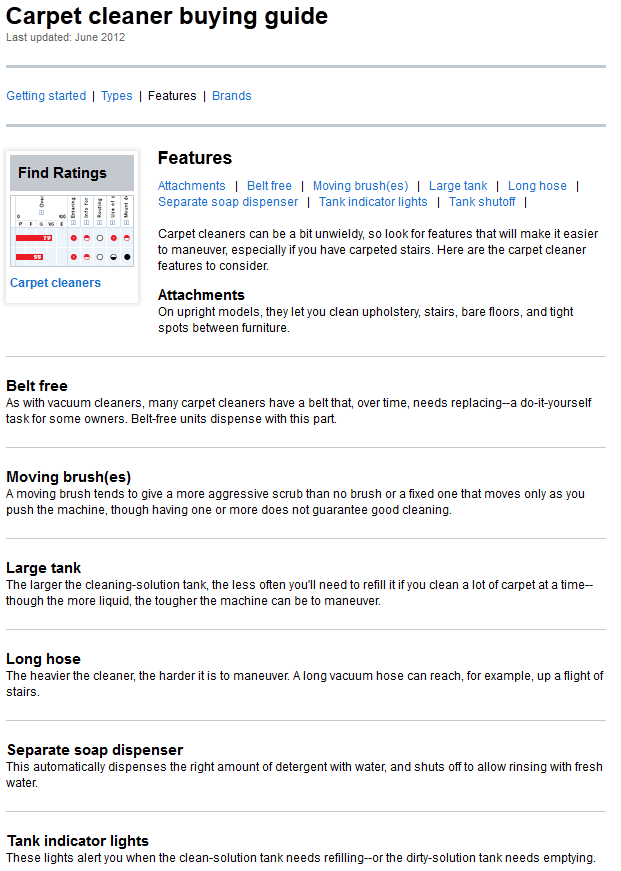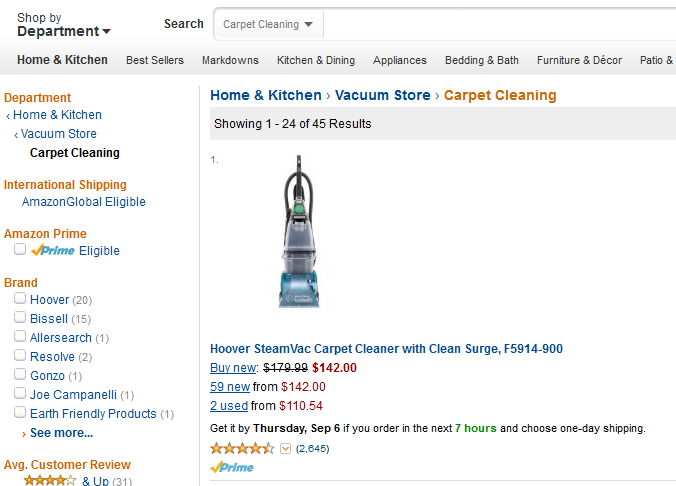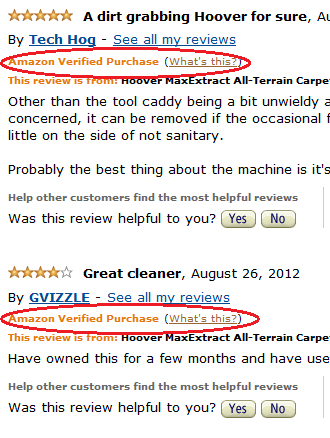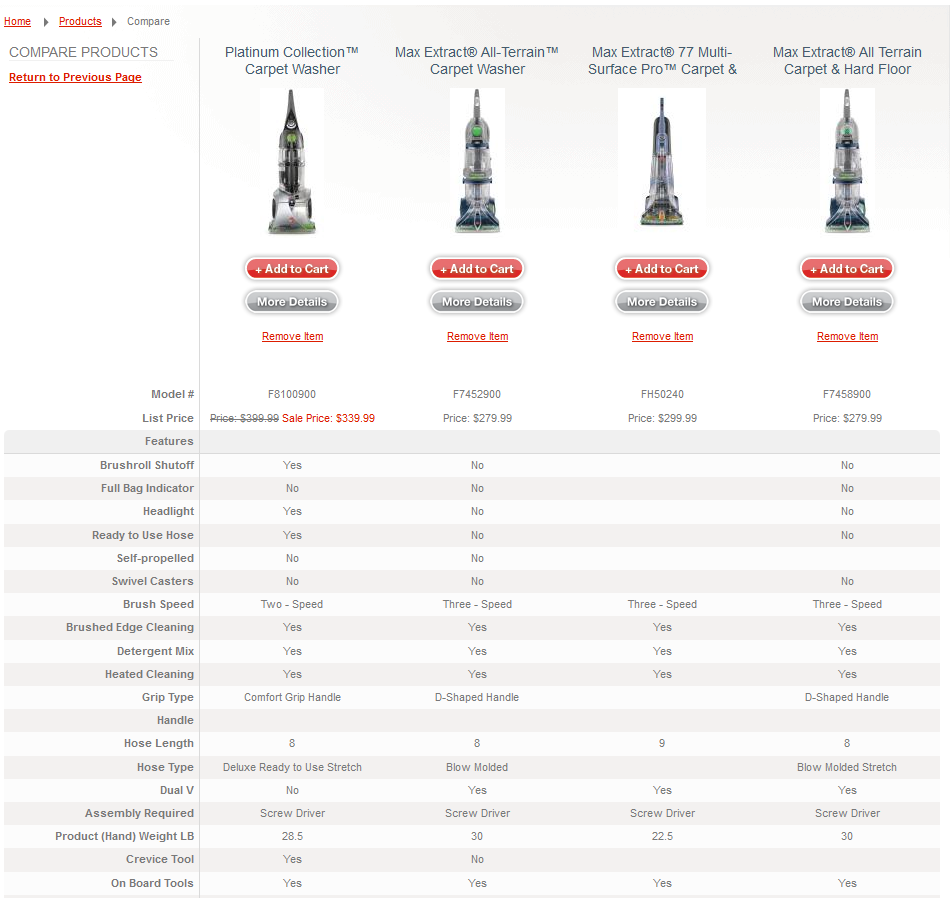Shopping is not an innate talent. It’s not something you’re born knowing how to do. It’s not coded into your DNA or your X-chromosome! It’s something you learn to do. You can learn through the examples and teachings of your parents and peers or you can acquire skills through your own trial and error.
This tutorial is for the young, the untutored, and the unknowing. If you were never taught how to shop and have had no interest, there are still some things you need to know. I’m not talking about how to go to the mall and endlessly dig through the clearance rack to find a bargain. I don’t have the patience for that either. I’m talking about when you need to make a significant or very large purchase.
My Examples
Carpet Cleaner – I have pets and therefore have regular messes that need cleaning up. I also recently replaced the carpet in my house and would like to keep it nice. This is a smaller purchase and not something that you want to invest a LOT of time in, but enough that you learn about the features of the products and check ratings before making your purchase.
New Car – In the fall, I helped my daughter shop for a new car. This is a large purchase. You will need to invest time in test driving and educating yourself about features and workmanship.
The amount of time that you spend on each step is directly proportional to the amount of money you’re spending on the item. For a car costing you tens of thousands of dollar that you will use every day for YEARS, you want to invest some time into your decision-making process. For a $10 water bottle (see my article on Bottled Water) you just want to check the reviews and make sure you aren’t buying junk that will leak and taste like plastic. Your attention will vary at the intervals in between.
Step 1: Educate yourself
You don’t necessarily need to become an expert about the type of product that you’re purchasing, but you do need to understand the features that are available so that you can decide what you need. In order to learn, you need to find someone who IS an expert. I recommend finding an independent lab that does testing on products, such as Consumer Reports. Consumer Reports does testing and rating of a lot of consumer products. They also have information about important features of products to educate you. If you’re car shopping, you can check them, or another good resource is Edmunds.
As a final resort, just Google it. When you Google, make sure you list the type of item it is as well. For example, when I Googled “carpet cleaners”, I got products and services for sale. When I Googled “carpet cleaners appliances” I got articles in About.com and Good Housekeeping. You can also add the word “Reviews” to your Google Search.
Consumer Reports has a nice Buying Guide that will educate you, otherwise, make sure you learn all you need to know.

Check the Date of the articles that you read! If the information is several years old, it may not be relevant. Read about types, features, and brands. Pay special attention to features. Decide what features are relevant to you. What are you willing to pay extra for? What do you expect to come standard? Evaluate your brand loyalty and open your mind to new possibilities. Just because something was well-made 10 years ago doesn’t mean it is still made with quality and excellence today.
My Examples of Step 1
Carpet Cleaner – Features that interested me were a long hose to clean stairs, a separate tank for detergent, and some attachments for upholstery. I have no brand loyalty.
Car – After checking used car prices and inventory, we determined that she would be better off buying a new car. Features that interested her were fuel economy, cabin size, horsepower, power windows/locks, cruise control, and an integrated iPod stereo system. I had previously owned 2 Toyotas, 1 Ford, and a Mazda, but we were willing to look around. She was looking at low end hatchbacks and small sedans.
Step 2: Check Ratings and Prices Online
From the independent rating companies like Consumer Reports and Edmunds, check out the ratings for the tested models. Jot down a few that interest you. For large purchases such as a car, check other sites like U.S. News or something that catches your attention in a Google Search.
Consumer Reports gives prices for appliances and such. Edmunds will tell you the price you should expect to pay for a new (or used) car. Determine your budget and use that to narrow down your search.
Amazon
Amazon is a fabulous tool for shoppers. Here are some tips for using Amazon for comparison shopping and ratings:
- Go to the category instead of doing a search. Sometimes things aren’t named properly to show up in a search, but if you go to the category, they’ll be there.

- Narrow the results. You can select certain brands, certain features, or do a sort. You can sort the products by price, ratings, or popularity. My favorite is popularity since this is based on how many of that item has been purchased on Amazon.
- Look at the reviews. There are 2 ways to sort all the customer reviews – Most helpful first and most recent first. I recommend using both of these. The most helpful reviews are rated by other users as being helpful in making their decision. It’s also important to check the dates. Manufacturers sometimes keep the same model number and just do updates to firmware or hardware. In recent years, most manufacturers have implemented cost-saving changes that mean shoddy workmanship and cheaper parts. Something that was good in 2008 might not be as good now. Here’s how to evaluate the reviews:
- Read a few of the most helpful reviews. They often include tips and tricks. For example, if someone complains about leaks, there may be a tip to help that.
- Re-sort and read a few of the most recent reviews. These are people that have purchased and reviewed the most current model or version of the model.
- Read a few of the 4-star reviews. These tend to be the most useful. People like the product but don’t love it and they’ll tell you why not.
- Look at a few of the 1-star reviews. These are the haters, but sometimes there’s a reason.
- Look at the distribution of reviews. This can tell you a lot about the product.

- Read through the BS. Online shopping is a big business and people (like me) increasingly rely on online reviews to make purchasing decisions. That means that businesses will pay money for good reviews. They will also pay someone to write a bad review of their competition. First, you need to be able to read through the BS. That is an ability that only comes with experience. However, there is something that Amazon does to help. Look for the “Amazon Verified Purchase” tag in the reviews. That means that Amazon promises that the reviewer actually owns the item they are reviewing.

Manufacturer Website
Once you get your product narrowed down to a couple of models, don’t forget to check the manufacturer website. They typically have a great comparison tool.

Step 3: Test Drive
Once you’ve narrowed your purchase down to a few models, you may want to “test drive” the item. For cars, head to the lot or dealership. DO NOT make a car purchase until you’ve driven everything on your list. For items like Pots and Pans, you’ll want to go to the store and feel a few items. You can tell a lot about the quality of an item by feeling it. For less expensive items like the earlier-mentioned Water Bottles, this step may not be necessary.
Examples
Carpet Cleaner – I decided not to look in local stores.
Car – While shopping for my daughter’s car, we had done all of our research. We had a few models picked out that we were interested in. We had done research on what we should pay and what features were available. We took that with us.
 We test drove all of the models on the list. She hated the Nissan, Ford, and Kias. The Toyota Yaris was ok, but felt a little cheap. The Honda was nice, but too expensive and a little too big for her. She loved the Mazda and Hyundai and chose the Hyundai based on horsepower, MPG and the better warranty.
We test drove all of the models on the list. She hated the Nissan, Ford, and Kias. The Toyota Yaris was ok, but felt a little cheap. The Honda was nice, but too expensive and a little too big for her. She loved the Mazda and Hyundai and chose the Hyundai based on horsepower, MPG and the better warranty.
Step 4: Price Comparison
Once you’ve decided on a model, do a price comparison. For cars, this means calling around to different dealerships and finding the best deal. This can be difficult if you’re looking to purchase a new model that’s flying out of inventory. This happened to us with my daughter’s Hyundai purchase and my 2006 Toyota Rav 4 purchase. If they won’t work with you on price, work on your trade in value and extras such as free updated floor mats and a free cable for your iPod.
To price compare consumer goods, try a site like Pricegrabber or a free mobile phone app like ShopSavvy available on: iPhone, Android, and Windows Phone.
Don’t forget to account for tax and shipping costs!
Examples
Carpet Cleaner – Amazon and Walmart had the same price. I’ve always been happy with Amazon returns, so I decided to purchase the machine from Amazon.
Car – My daughter ended up getting a 2012 Hyundai Accent. The dealerships had limited stock and wouldn’t come down from the sticker price. However, we did get a few freebies added in and got a great trade-in price on her old car. She had driven it for about a year and we got what she had paid for it in trade. She also got a great interest rate on her loan and is now paying less than $200 a month for her 2012 car.




